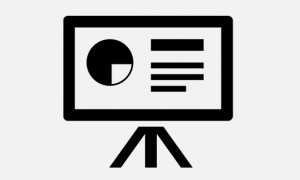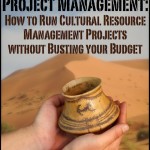 With the Society for American Archaeology (SAA) conference just behind us and the call for papers for the 2014 Society for Historical Archaeology (SHA) conference just around the corner, I started thinking about all the CRM archaeology projects I’ve worked on that I turned into academic presentations at these two international conferences. Except for two times when I had family things to deal with, I’ve attended at least one of these big conferences every year since 2004. I’d have to say, at the sake of sounding like a complete geek, these conferences are among the highlights of my archaeological year.
With the Society for American Archaeology (SAA) conference just behind us and the call for papers for the 2014 Society for Historical Archaeology (SHA) conference just around the corner, I started thinking about all the CRM archaeology projects I’ve worked on that I turned into academic presentations at these two international conferences. Except for two times when I had family things to deal with, I’ve attended at least one of these big conferences every year since 2004. I’d have to say, at the sake of sounding like a complete geek, these conferences are among the highlights of my archaeological year.
Almost all of the presentations I’ve given were based on CRM archaeology and historic preservation projects. The information I included in my presentations was typically stuff that was beyond the project’s scope of work that didn’t make it into the final report. It was information that I’d already researched in-depth, but wasn’t necessary for the report or was above and beyond what was necessary to complete the contract.
I didn’t want this data to go to waste, so I put in some extra, unpaid hours to polish the info into an academic presentation. Sometimes it was hard work. It was oftentimes discouraging to go through my company’s peer-review process and have supervisors and co-workers rip my presentations to pieces, but, in the end, I had a product I was proud of that expanded archaeological knowledge and disseminated important ideas. Best of all, I got paid to give almost all of these speeches!
After having heard a lot of conference presentations across the United States, Canada, and in the United Kingdom, I have five tips for anyone that is thinking about presenting on a CRM project. These tips are based on my previous experiences and may not apply to all situations or research projects.
Here we go:
1) Get your permissions first- This is so crucial for public presentations on information collected for clients. I am not a lawyer, but CRM companies have a duty to provide professional advice to their clients in a manner that prevents them from violating laws. We also have an obligation to keep certain information confidential indefinitely (For instance, site locations and photographs of Native American burials are usually redacted from CRM reports in order to protect the resource). It is unprofessional to share confidential information and it may get your company sued.
Additionally, a CRM company’s products (i.e. reports, data, expertise) is their own property. You may not be able to give this information away for free (This is somewhat odd considering we are mandated to give a copy of our reports to the State Historic Preservation Office, which means we give away our product to the public. I’m not sure how this works, but other CRM companies have proprietary presses that sell their reports [ex. SRI Press]).
Basically, you should get permission from your client and supervisor before you even think about making a conference presentation. This is essential.
2) Present what you find interesting- We all have personal research interests that are seldom employed in CRM work. For instance, I’m a “historical archaeologist” with a special interest in race and consumerism. But, I haven’t worked on a historical archaeological site since April, 2012. Instead, I’ve found dozens of prehistoric sites and documented historical buildings.
There is always a kernel of information in each of these projects that I do find interesting (see my post on Personal Research and CRM sanity). I don’t find Hohokam sites particularly interesting, but I do think it’s interesting that the rise of cotton farming in Arizona during the early twentieth century mirrors the boundaries of the Hohokam homeland, who, incidentally, were big-time cotton barons in the medieval Southwest. (BTW: This is a topic I plan on pursuing in future presentations.)
Choosing a topic that you find interesting serves two purposes: it keeps you motivated to go the extra mile, even when you’re not getting paid to do the research, and it keeps you interested in CRM projects that are not within the range of your research interests.
3) Fill data gaps- Whenever possible, try to fill data gaps with your presentations. This is important because, as a proportion of all archaeology in the United States, CRM commands a huge amount of the total money spent on archaeology each year. I can’t find a reference, but I recall a veteran principal investigator tell me that CRM archaeology gets about 10 times the amount of funding as academic and private archaeology ventures. With all that money flowing into the thousands of CRM projects that go down each year, using what we CRMers discover to fill existing data gaps is the least we can do.
Sometimes the presentations that fill data gaps become works that are frequently cited in subsequent archaeology literature. I have some presentations that are more comprehensive than any article on the subject and I cite these references liberally.
4) Make a single statement- The presentations at large conferences are usually 20 to 15 minutes long. This is not enough time to adequately address any more than a single thesis statement or research question. Some of the worst presentations I’ve ever seen tried to cover too many topics in that short time period. Don’t do that to your reputation or your company’s rep.
5) Write your presentation down- While it’s not advisable to simply read your presentation word-for-word, you really do need to write your presentation down so other researchers have something they can cite in the future. The best presenters are older CRM PIs that do a combination of shooting from the hip and reading from a script. Unfortunately, these CRMers rarely have a Microsoft Word document of their presentation that I can use in the future. Their presentation immediately has the same value as a good television commercial–it may have piqued my interest, but it went in one ear and out the other.
If you really want to further the field and spread your information, I strongly urge you to write down your presentation. If you don’t have time to write a whole “paper”, a comprehensive outline on a Word doc is better than nothing.
CRM projects are an excellent way to spread information about archaeology and historic preservation to a wider audience. It only takes a few hours of additional effort to create a Powerpoint and presentation that will greatly help your field. If you have any questions or want copies of my previous presentations, don’t hesitate to ask.
I’d love to hear from all of you. Please send me an email or write a comment below. If you have any questions or comments, write below or send me an email.
 Small Archaeology Project Management is now on the Kindle Store. Over 300 copies were sold in the first month! Click Here and see what the buzz is all about
Small Archaeology Project Management is now on the Kindle Store. Over 300 copies were sold in the first month! Click Here and see what the buzz is all about
Learn how my résumé-writing knowledge helped four of my fellow archaeologists land cultural resources jobs in a single week!
Join the Succinct Research email list and receive additional information on the CRM and heritage conservation field.


